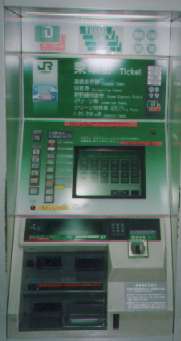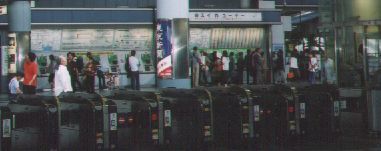Discount tickets bought only outside Japan If you travel around Japan by train, they are worth being bought; much cheaper than the standard of the fare of other tickets inside Japan.
Which is better, standard pass or Green pass? Of course it may depend on each one's decision (Most young travelers will no doubt buy standard one), but Green car has a certain advantage almost same as that of Europe or other countries; more space, more comfortable seats, and less passengers.
When you use non-reserved cars, simply get on with this pass. In the case of reserved cars, booking can be made at Midori no madoguchi, ticket offices in JR stations. This pass covers the area of JR-East railway; that is, eastern half part of Japan except Hokkaido Island. 5 days for 20,000 yen, 10 days for 32,000 yen, flexible 4 days (within one month) for 20,000 yen. The normal return fare from Tokyo to Sendai by Shinkansen is 21,180 yen, to Aomori is 32,040 yen. Green pass is also available. If your destination is limited within eastern Japan, this is also a good bargain.
Normal tickets If you travel without using a pass above, there are following tickets. Tickets and booking are available at the Midori no madoguchi, ticket offices of JR, or most travel agencies. All stations except small ones have this Midori no madoguchi.The translation of this word is 'Green counter', but confusingly, Midori no madoguchi is completely different facility from Gurin caunta (The 'Janglish' word of Green counter) which is a counter of JR-East to accept complaints from customers.
It is valid to local trains (including rapid trains) only. Normal tickets more than 100 km allow you unlimited times of stopover. It is valid for a 100 to 200 km trip, with an extra day for each extra 200 km. Note that the fare of normal ticket per kilometer fairly reduces as the distance increases. It is much cheaper not to separate the ticket on the way.
When you use Shinkansen and Limited Express trains, both normal ticket and this Limited Express ticket is required. There are two types: tickets for reserved seats and those for non-reserved seats. The former ones is usually 520 yen higher than the latter (Varies slightly according to seasons or trains). This ticket is valid to just one train, one time; stopover is not allowed. When you get on sleeper cars or Green car (1st class), additional fare and ticket is required.  How to Buy Tickets in Japan
How to Buy Tickets in JapanTicket is sold at Midori no madoguchi, ticket counters shown above. Besides, ticket bending machine is widely used in Japanese railways. In the case of urban railways, subways, and short distance trip, almost all passengers buy tickets using machine. Ticket bending machine might be confusing at first because it sells so many kind of ticket and has many buttons. Cost of ticket to your destination is usually shown above bending machines. Some machines can even reserve ticket of Shinkansen and limited express trains.  All Japanese railways stations except small ones without staff in rural area have ticket barrier. Tickets
are also checked by conductor in Shinkansen and limited express trains. In urban area, most station
have ticket barrier machine. It reads ticket by information recorded by magnet in ticket. In rural area,
many station does not have staff and no conductor in train for cutting cost, so in the case of country local train, you pay fare to motor man when getting off train.
All Japanese railways stations except small ones without staff in rural area have ticket barrier. Tickets
are also checked by conductor in Shinkansen and limited express trains. In urban area, most station
have ticket barrier machine. It reads ticket by information recorded by magnet in ticket. In rural area,
many station does not have staff and no conductor in train for cutting cost, so in the case of country local train, you pay fare to motor man when getting off train.It might be troublesome to buy tickets in Japan for travellers. Using the application form in this webpage, it will be easier to do this task. Even if you would not be confident about speaking Japanese, there will be little trouble just printing and filling in this form then showing it to attendants. Ticket Application Form Example of using this form Smart Card In urban area, smart card system is now widely used, such as Suica (JR East, Tokyo metropolitan area), PASMO (Major private railways and subway, Tokyo metropolitan area), ICOCA (JR West, Kansai metropolitan area), PiTaPA (Major private railways and subway, Kansai and Nagoya metropolitan area). They deposit 500yen when buying at first, and passengers charge money to those card. After charging, passengers go through ticket barrier machine only by touching the sensor without taking trouble to by ticket. They are also valid to shops in stations or some stores outside station as e-money.
Reservation (Yoyaku) Is it better to make a booking previously? Well, in general, you do not have to. Aside from 'Nozomi' express in Tokaido/ Sanyo Shinkansen and many overnight trains, almost all the trains have non-reserved seats. But in some cases, congestion is expected and seats are not guaranteed without reservation. Shinkansen trains They sometimes heavily crowded. Not only vacation seasons, but also weekdays in the morning and evening owing to the business demand. Especially in Tokaido Shinkansen such customers are dominant rather than tourists. If you leave Tokyo or Shin-Osaka station, it is all right because you have only to queue for the non-reserved car of next train because they depart quite frequently. It is better to avoid getting on Shinkansen on the way from Shin-Yokohama, Ueno, Omiya when congestion is expected. All the seats may be already occupied at the starting station.
Trains that leave Tokyo or Osaka in Saturday/ Sunday morning or the beginning of New Year's holidays, 'Golden week' in May, 'O-bon' holidays in August are often heavily congested. And the ones which arrive at Tokyo and Osaka in Sunday afternoon or the end of these three major holidays are the same. New Year holiday is approximately from 28 Dec. to 6 Jan., Golden week from 29 Apr. to 5 May., O-bon from 11 to 20 Aug. Still, trains are OK. Traffic jams whose length are as long as 30 or 50 kilometers occur in major highways during these periods!
When all trains are heavily packed and no chance to get a seat in non-reserved car, better to stay in the deck of reserved car than stand in the aisle of non-reserved car filled with passengers. Once you get into such crowded car, even difficult to move and go to toilet. Wait train in 'reserved car' place in the station, far from long non-reserved car queues.
During the seasons of 'Seishun 18 kippu', it is difficult to make bookings of these trains.
There are many discount passes in Japan. They are available at the Midori no madoguchi and travel agencies as well. But the discount rates of them are usually not so attractive as the passes for oversea travelers. Perhaps the most notable one is 'Seishun 18 kippu', special seasonal discount ticket for local trains.
INDEX OF TIPS |